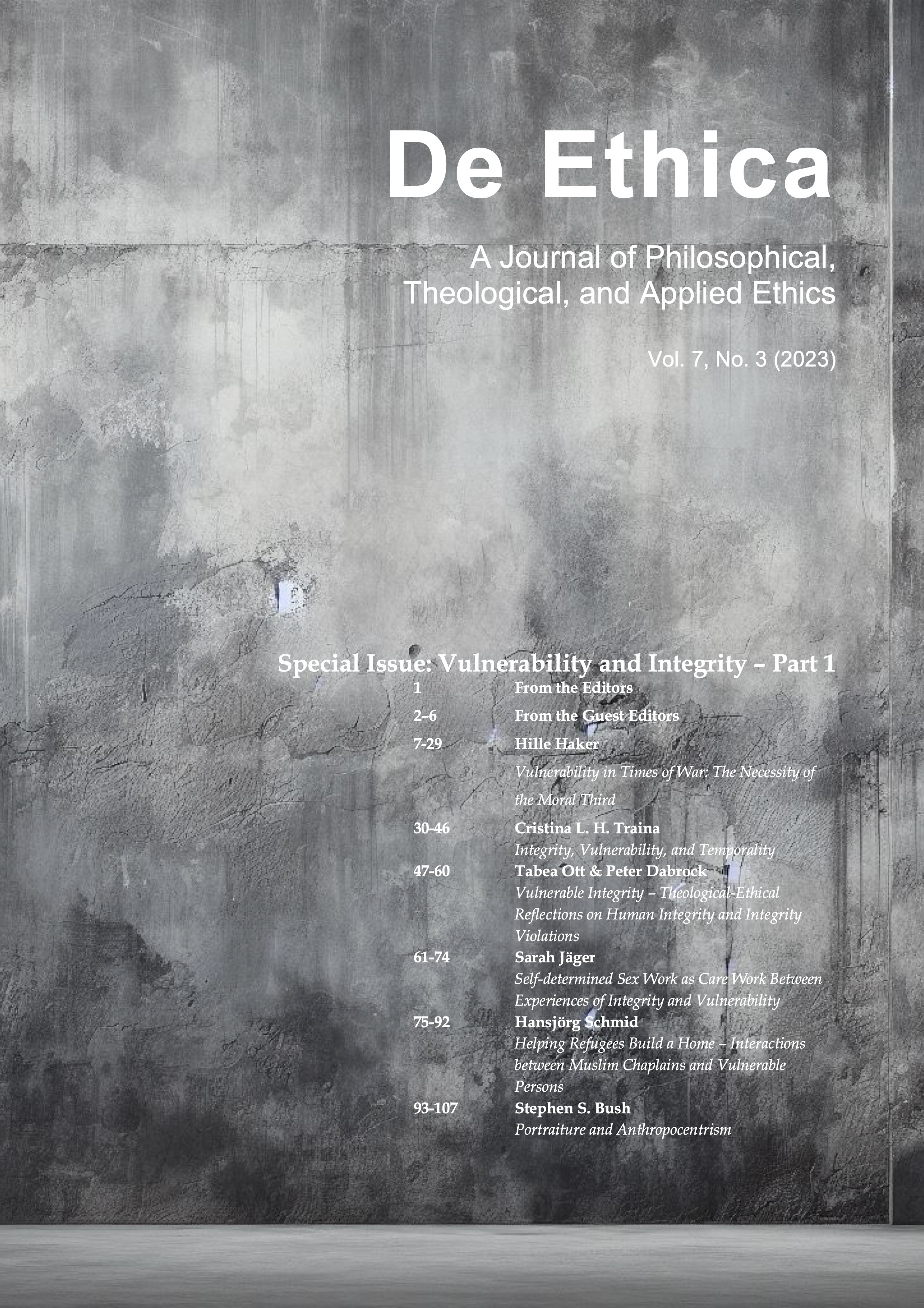Portraiture and Anthropocentrism
DOI:
https://doi.org/10.3384/de-ethica.2001-8819.237393%20Keywords:
Ecological ethics, climate change, art, portraiture, anthropocentrism, Alice NeelAbstract
In an age in which anthropocentrism is increasingly under fire, the investment of the artistic tradition in that paradigm deserves particular attention. Portraiture is especially significant, as it seems to be the anthropocentric art form par excellence. It seems to reinforce key features of anthropocentrism: the distinction of the human from the nonhuman and the superiority of the former over the latter. We can pursue these questions most effectively if we distinguish descriptive (“weak”) anthropocentrism from normative (“strong”) anthropocentrism. The former involves some sort of focus on humans, the latter combines this with claims about their superiority over the nonhuman. Certain works by influential portraitists, such as Pablo Picasso, Frida Kahlo, and Ana Mendieta, contest both weak and strong anthropocentrism. Other portraits seem to be involved in weak anthropocentrism, but not necessarily strong anthropocentrism. Considering the artwork of Alice Neel and the philosophy of Judith Butler, I argue that such works have an important ethical role to play in orienting us in our relationships with humans, precisely in resisting strong anthropocentrism even in expressing weak anthropocentrism.
References
Barad, Karen Michelle. Meeting the Universe Halfway: Quantum Physics and the Entanglement of Matter and Meaning. Durham, N.C.: Duke University Press, 2007.
Baum, Kelly, Andrea Bayer, and Sheena Wagstaff. “Introduction: An Unfinished History of Art.” In Unfinished: Thoughts Left Visible, edited by Baum, Kelly, Bayer, Andrea, and Wagstaff, Sheena, 13–15. Metropolitan Museum of Art, 2016.
Baum, Kelly, and Randall Griffey. “Anarchic Humanist.” In Alice Neel: People Come First, edited by Kelly Baum and Randall Griffey, 13–25. New York: Metropolitan Museum of Art, 2021.
Bennett, Jane. The Enchantment of Modern Life: Attachments, Crossings, and Ethics. Princeton, N.J: Princeton University Press, 2001.
———. Vibrant Matter: A Political Ecology of Things. Durham, N.C.: Duke University Press, 2010.
Berger, John. Ways of Seeing. New York: Penguin, 1990.
Bryan-Wilson, Julia. “Alice Neel’s ‘Good Abstract Qualities.’” In Alice Neel: People Come First, edited by Kelly Baum and Randall Griffey, 103–13. New York: Metropolitan Museum of Art, 2021.
Butler, Judith. Frames of War: When Is Life Grievable? London; New York: Verso, 2009.
———. Precarious Life: The Powers of Mourning and Violence. London; New York: Verso, 2004.
Cosgrove, Denis. “Prospect, Perspective and the Evolution of the Landscape Idea.” In Reading Human Geography: The Poetics and Politics of Inquiry, edited by Trevor Barnes and Derek Gregory, 324–42. New York: John Wiley & Sons, 1997.
———. Social Formation and Symbolic Landscape. London: Croom Helm, 1984.
Derrida, Jacques. The Gift of Death & Literature in Secret. Translated by David Wills. Chicago: University of Chicago Press, 2017.
Falkenhausen, Susanne von. Beyond the Mirror: Seeing in Art History and Visual Culture Studies. Translated by Nicholas Grindell. Bielefeld: transcript Verlag, 2020.
Freeland, Cynthia A. Portraits and Persons: A Philosophical Inquiry. Oxford ; Oxford University Press, 2010.
Gambari, Olga. “Magical Body, Political Body.” In Ana Mendieta: She Got Love, edited by Beatrice Merz, Bilingual ed., 22–57. Milano, Italy: Skira, 2013.
Hoban, Phoebe. Alice Neel: The Art of Not Sitting Pretty. New York: St. Martin’s Press, 2010.
Honig, Bonnie. Antigone, Interrupted. Cambridge; New York: Cambridge University Press, 2013.
Krause, Sharon R. “Environmental Domination.” Political Theory 48, no. 4 (2020): 443–68.
Levinas, Emmanuel. Totality and Infinity: An Essay on Exteriority. Translated by Alphonso Lingis. Pittsburgh: Duquesne University Press, 1969.
Mulvey, Laura. “Visual Pleasure and Narrative Cinema.” Screen 16, no. 3 (Autumn 1975): 6–18.
Mylius, Ben. “Three Types of Anthropocentrism.” Environmental Philosophy 15, no. 2 (2018): 159–94.
Olin, Margaret. “Gaze.” In Critical Terms for Art History, edited by Robert S. Nelson and Richard Shiff, 2nd ed., 318–29. Chicago: University of Chicago Press, 2003.
Page, Joanna. “Planetary Art beyond the Human: Rethinking Agency in the Anthropocene.” The Anthropocene Review 7, no. 3 (2020): 273–94.
Pérez, Laura E. Eros Ideologies: Writings on Art, Spirituality, and the Decolonial. Duke University Press, 2019.
Pettit, Philip. Republicanism: A Theory of Freedom and Government. Oxford; New York: Clarendon Press, 1997.
Phillips, Anne. The Politics of the Human. Cambridge, U.K.: Cambridge University Press, 2015.
Puar, Jasbir. “‘I Would Rather Be a Cyborg than a Goddess’: Becoming-Intersectional in Assemblage Theory.” PhiloSOPHIA: A Journal of Continental Feminism 2, no. 1 (2012): 49–66.
Putnam, Michael. “Reverence the Stones: The Ethics of Environmental Attention.” PhD Dissertation, Brown University, forthcoming.
Rose, Gillian. Feminism and Geography: The Limits of Geographical Knowledge. Cambridge, U.K.: Polity Press, 1993.
———. “Looking at Landscape: The Uneasy Pleasures of Power.” In Reading Human Geography: The Poetics and Politics of Inquiry, edited by Trevor Barnes and Derek Gregory, 342–54. New York: John Wiley & Sons, 1997.
Schor, Mira. “Some Notes on Women and Abstraction and a Curious Case History: Alice Neel as a Great Abstract Painter.” Differences: A Journal of Feminist Cultural Studies 17, no. 2 (2006): 132–60.
Setten, Gunhild. “Landscapes of Gaze and Practice.” Norsk Geografisk Tidsskrift - Norwegian Journal of Geography 57 (2003): 134–44.
Stewart-Kroeker, Sarah. La Terre Martyre. Geneva, Switzerland: Labor et Fides, 2022.
West, Shearer. Portraiture. Oxford History of Art. Oxford: Oxford University Press, 2004.
Wheaton, A. W. “Feminist Philosophy of Art.” Philosophy Compass 3, no. 5 (2008): 873–93.
Downloads
Published
How to Cite
Issue
Section
License
Copyright (c) 2023 Stephen Bush

This work is licensed under a Creative Commons Attribution 4.0 International License.

